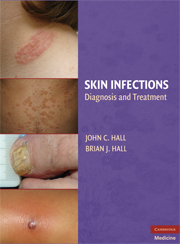Book contents
- Frontmatter
- Contents
- List of Contributors
- Acknowledgments
- INTRODUCTION
- TECHNIQUES IN DIAGNOSING DERMATOLOGIC MANIFESTATIONS OF INFECTIOUS DISEASES
- PRINCIPLES OF MANAGEMENT OF DERMATOLOGIC INFECTIONS IN THE SKIN
- PART 1 COMMON INFECTIONS
- PART II LESS COMMON INFECTIONS
- PART III INFECTIONS IN SELECTED ECOSYSTEMS
- PART IV INFECTIONS IN SELECTED PATIENT POPULATIONS
- 13 SKIN INFECTIONS IN HIV PATIENTS
- 14 INFECTIONS IN ORGAN TRANSPLANT PATIENTS
- 15 CANCER PATIENTS AND SKIN INFECTIONS
- 16 SKIN INFECTIONS IN PEDIATRIC PATIENTS
- 17 SKIN INFECTIONS IN THE ELDERLY
- 18 SKIN INFECTIONS IN ATHLETES
- 19 SKIN INFECTIONS IN DIABETES MELLITUS
- PART V INFECTIONS OF SPECIFIC SKIN-ASSOCIATED BODY SITES
- PART VI SPECIAL DISEASE CATEGORIES
- Index
18 - SKIN INFECTIONS IN ATHLETES
from PART IV - INFECTIONS IN SELECTED PATIENT POPULATIONS
Published online by Cambridge University Press: 08 January 2010
- Frontmatter
- Contents
- List of Contributors
- Acknowledgments
- INTRODUCTION
- TECHNIQUES IN DIAGNOSING DERMATOLOGIC MANIFESTATIONS OF INFECTIOUS DISEASES
- PRINCIPLES OF MANAGEMENT OF DERMATOLOGIC INFECTIONS IN THE SKIN
- PART 1 COMMON INFECTIONS
- PART II LESS COMMON INFECTIONS
- PART III INFECTIONS IN SELECTED ECOSYSTEMS
- PART IV INFECTIONS IN SELECTED PATIENT POPULATIONS
- 13 SKIN INFECTIONS IN HIV PATIENTS
- 14 INFECTIONS IN ORGAN TRANSPLANT PATIENTS
- 15 CANCER PATIENTS AND SKIN INFECTIONS
- 16 SKIN INFECTIONS IN PEDIATRIC PATIENTS
- 17 SKIN INFECTIONS IN THE ELDERLY
- 18 SKIN INFECTIONS IN ATHLETES
- 19 SKIN INFECTIONS IN DIABETES MELLITUS
- PART V INFECTIONS OF SPECIFIC SKIN-ASSOCIATED BODY SITES
- PART VI SPECIAL DISEASE CATEGORIES
- Index
Summary
INTRODUCTION
Cutaneous infections afflict athletes sometimes in epidemic proportions. Several aspects of sporting activities place the athlete at a greater risk of developing and transmitting these infections. First, many athletic endeavors involve intense, close skin-to-skin contact, which facilitates the spread of infectious microorganisms between athletes and among teams. Second, sweating, inherent to athletics, results in a macerated epidermis that easily facilitates the penetration of microorganisms. Third, many athletes wear occlusive equipment, which provides an ideal environment for the growth of microorganism (warm, dark, and moist). Finally, trauma (gross or micro) related to athletic activities further impairs the stratum corneum's barrier.
The microorganisms that plague athletes of all skill levels include bacteria, viruses, fungi, atypical mycobacteria, and parasites. Knowledge of these infections in the context of athletics permits the clinician to treat the athletic patient more effectively. Through this focused approach, the clinician can minimize disruption to an individual's athletic activities and prevent team and league epidemics.
HISTORY
Sports dermatology began with several isolated case reports of unusual skin conditions in athletes. Interest in the field blossomed with the identification of epidemics of viral, fungal, and bacterial skin infections among those involved in sports of all kinds. The transmission of herpes virus among athletes with close skin-to-skin contact (primarily among wrestlers) has predominated in the sports dermatology literature. Research and close observation in the 1990s and early 2000s also documented epidemics of tinea corporis gladiatorum.
- Type
- Chapter
- Information
- Skin InfectionsDiagnosis and Treatment, pp. 238 - 245Publisher: Cambridge University PressPrint publication year: 2009



